The MSI GE66 gaming laptop has an interesting design with plenty of RGB lighting, as well as some powerful specs inside, let’s check it out in this detailed review and find out if it’s worth it. 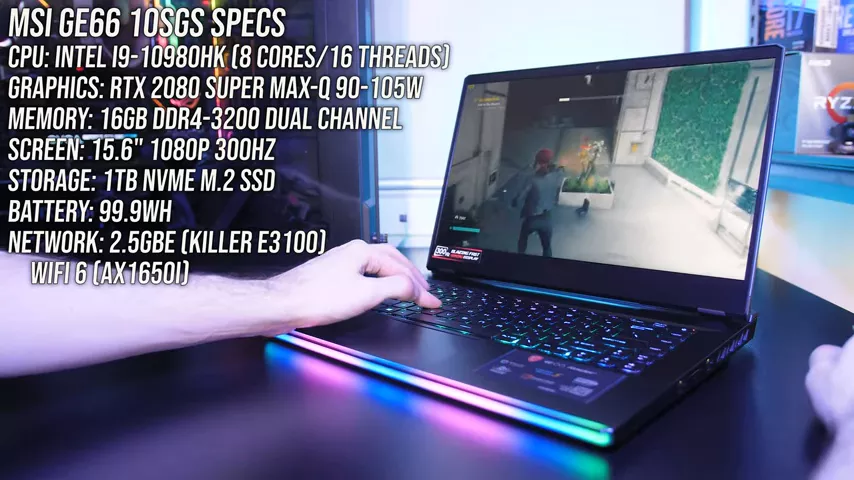 I’ve got the top end configuration with 8 core i9 processor and Nvidia RTX 2080 Super Max-Q graphics which can boost up to 105 watts thanks to dynamic boost, so I’m expecting good things from this hardware.
I’ve got the top end configuration with 8 core i9 processor and Nvidia RTX 2080 Super Max-Q graphics which can boost up to 105 watts thanks to dynamic boost, so I’m expecting good things from this hardware.
The lid is a matte silver metal, while the interior is a darker more blue colour, but also metal finish.  Overall build quality feels above average, and there aren’t any sharp corners or edges. MSI lists the weight as 2.38kg, and mine was just slightly above this.
Overall build quality feels above average, and there aren’t any sharp corners or edges. MSI lists the weight as 2.38kg, and mine was just slightly above this.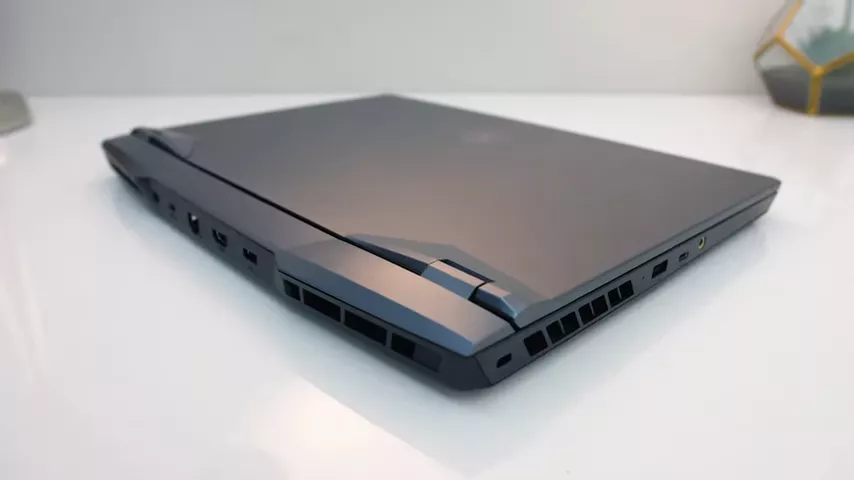 With the 230 watt power brick and cables for charging the total rises to 3.3kg or 7.3lb.
With the 230 watt power brick and cables for charging the total rises to 3.3kg or 7.3lb. 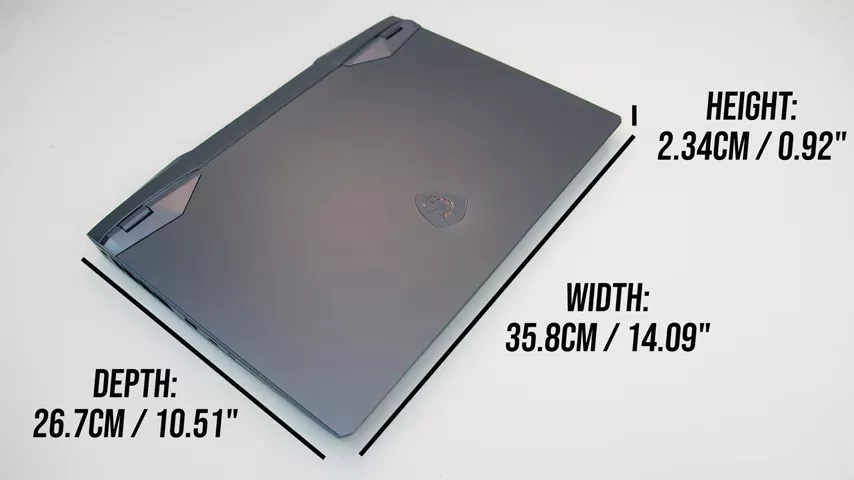 The GE66 isn’t too large, perhaps a little deeper than some others and a bit over 2cm thick, so while not thin, it’s not big either. Screen bezels are 8mm on the sides, though the bottom chin is larger.
The GE66 isn’t too large, perhaps a little deeper than some others and a bit over 2cm thick, so while not thin, it’s not big either. Screen bezels are 8mm on the sides, though the bottom chin is larger.
The 15.6” 1080p screen is available in 144Hz, 240Hz, or 300Hz options. Although we have the option of disabling Optimus through software which will boost gaming performance, there’s no G-Sync. 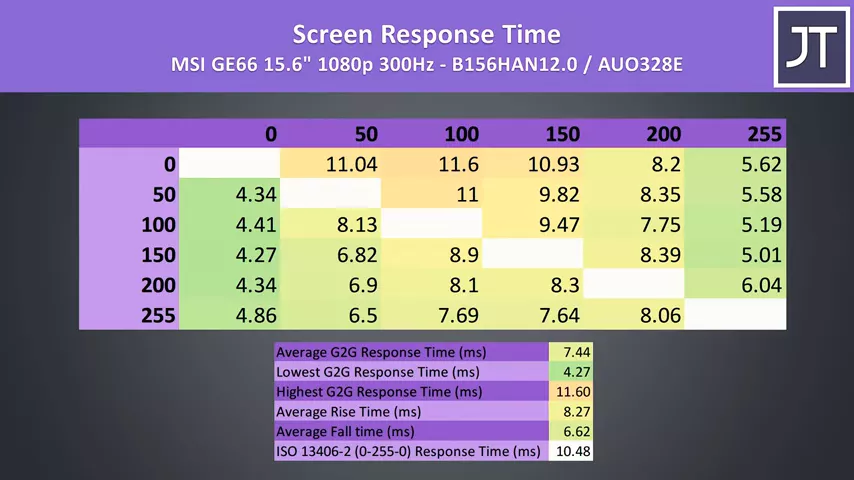 I measured the average grey-to-grey response time of the 300Hz screen at 7.4ms.
I measured the average grey-to-grey response time of the 300Hz screen at 7.4ms. 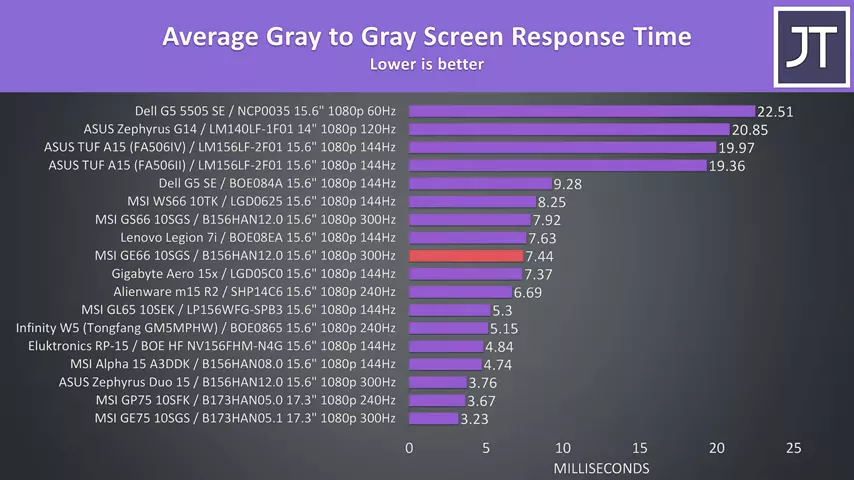 When we look at how this compares against others, it’s not too bad, but definitely on the lower side for a 300Hz panel given we need 3.3ms to complete the transition within the refresh window.
When we look at how this compares against others, it’s not too bad, but definitely on the lower side for a 300Hz panel given we need 3.3ms to complete the transition within the refresh window.
I’ve tested the screen with the Spyder 5, and got 98% of sRGB, 70% of NTSC, 76% of AdobeRGB and 76% of DCI-P3. At 100% brightness I measured the panel at 308 nits in the center with an 1100:1 contrast ratio, so some nice results for a gaming laptop. 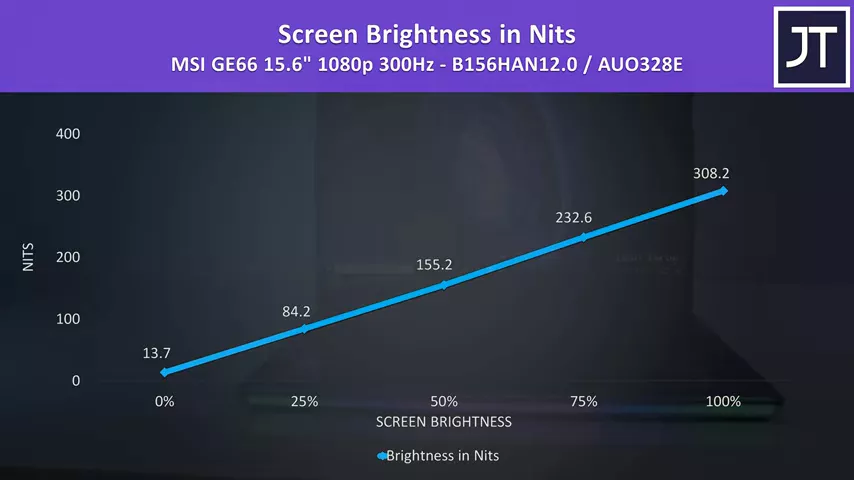 There was some backlight bleed detected in this worst case, I never noticed it when viewing darker content, but this will vary between panels.
There was some backlight bleed detected in this worst case, I never noticed it when viewing darker content, but this will vary between panels. Screen flex was on the lower side when intentionally trying to move it, it felt fairly solid due to the metal exterior. The hinge design is a little different to other MSI laptops that I’ve tested, they seem decent but only time will tell how well they hold up. Keyboard flex was also on the lower side when pushing down hard, no problems with build quality during normal use. I could easily open it up with one finger as the weight is fairly evenly distributed, it felt fine sitting on my lap.
Screen flex was on the lower side when intentionally trying to move it, it felt fairly solid due to the metal exterior. The hinge design is a little different to other MSI laptops that I’ve tested, they seem decent but only time will tell how well they hold up. Keyboard flex was also on the lower side when pushing down hard, no problems with build quality during normal use. I could easily open it up with one finger as the weight is fairly evenly distributed, it felt fine sitting on my lap.
Despite thinner screen bezels, MSI has the 1080p camera up top in the middle. 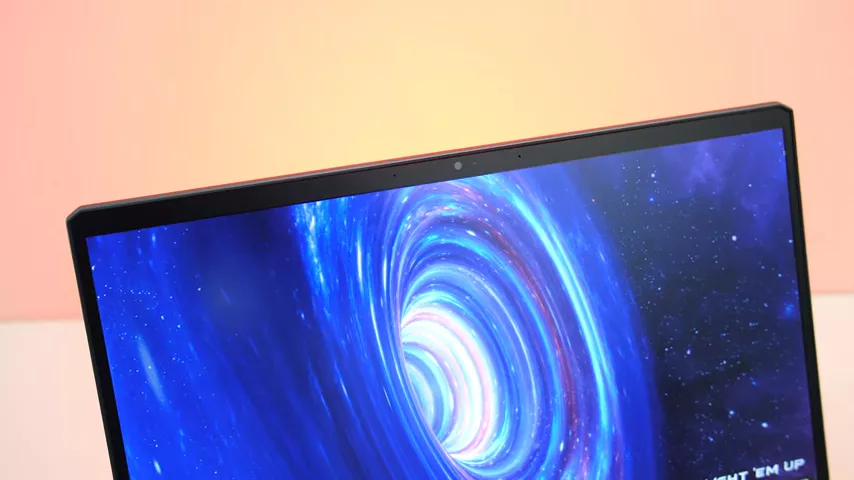 The steelseries keyboard has per key RGB backlighting which illuminates all keys and secondary key functions
The steelseries keyboard has per key RGB backlighting which illuminates all keys and secondary key functions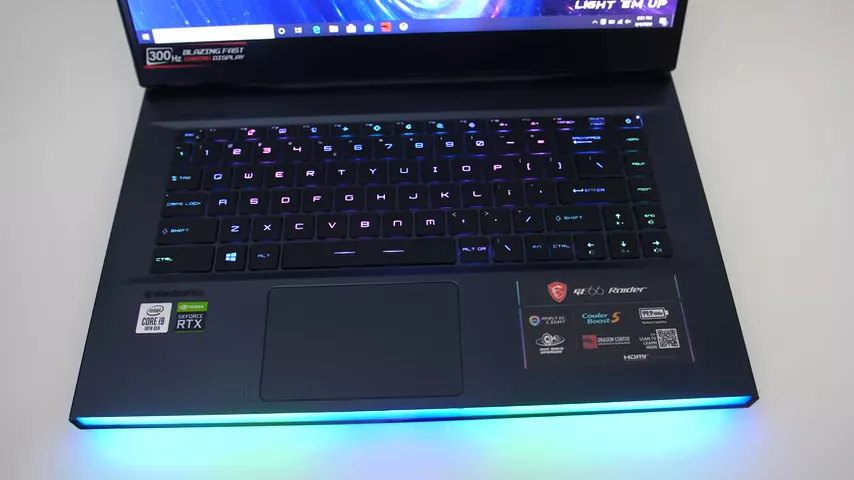 though the keys aren’t quite as bright as others from MSI like the GP75 which has clear sides. There are 3 levels of key brightness, or you can turn it off if you prefer. It felt kind of similar to the GS66, good to type with and a little clicky.
though the keys aren’t quite as bright as others from MSI like the GP75 which has clear sides. There are 3 levels of key brightness, or you can turn it off if you prefer. It felt kind of similar to the GS66, good to type with and a little clicky.
The only thing I didn’t like with the keyboard was the power button is in the top right next to delete, so you might want to change the default behaviour in windows otherwise an accidental press will put it to sleep. The precision touchpad clicks down anywhere, it feels smooth and works well. It’s using most of the available space but isn’t that large, and this seems to be due to the keyboard being pushed down a little to the front as the screen hinge isn’t right at the back, and the hinge areas kind of stick up higher than the rest of the machine.
Fingerprints show up easily on both the matte interior and lid, but as a smooth surface they’re easy enough to clean with a microfiber cloth.
 On the left from the back there’s a kensington lock slot, air exhaust vent, USB 3.2 Gen 2 Type-A port, USB 3.2 Gen2 by 2 Type-C port for up to 20 gigabit transfer speeds, and 3.5mm audio combo jack.
On the left from the back there’s a kensington lock slot, air exhaust vent, USB 3.2 Gen 2 Type-A port, USB 3.2 Gen2 by 2 Type-C port for up to 20 gigabit transfer speeds, and 3.5mm audio combo jack.  On the right from the front there’s a USB 3.2 Gen1 Type-A port, SD card slot, another USB 3.2 Gen1 Type-A port, and an air exhaust vent on this side too.
On the right from the front there’s a USB 3.2 Gen1 Type-A port, SD card slot, another USB 3.2 Gen1 Type-A port, and an air exhaust vent on this side too. 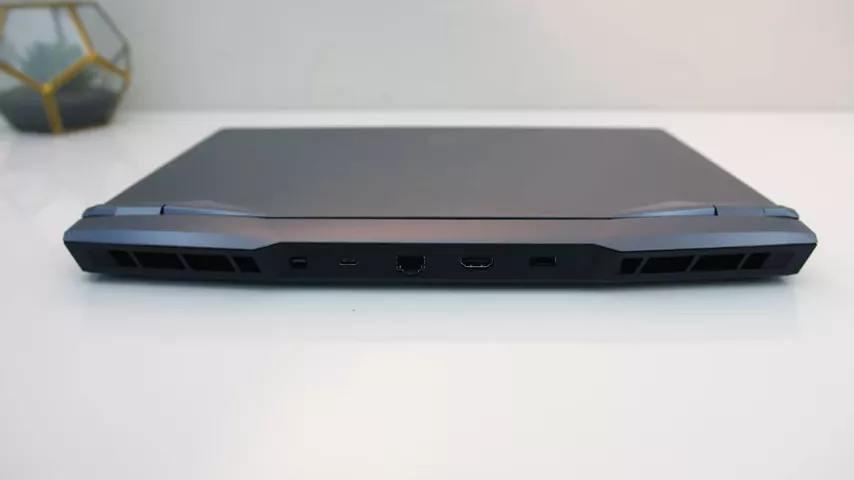 The rest of the I/O is on the back between another two air exhausts, from left to right we’ve got a mini DisplayPort 1.4 output, USB 3.2 Gen2 Type-C with DisplayPort 1.4 support, no Thunderbolt on this machine though, followed by 2.5 gigabit ethernet, HDMI 2.0 output, and the power input which is not using a standard barrel plug.
The rest of the I/O is on the back between another two air exhausts, from left to right we’ve got a mini DisplayPort 1.4 output, USB 3.2 Gen2 Type-C with DisplayPort 1.4 support, no Thunderbolt on this machine though, followed by 2.5 gigabit ethernet, HDMI 2.0 output, and the power input which is not using a standard barrel plug.
As we can just disable optimus, it’s no surprise that all display outputs are wired to the Nvidia graphics. Unfortunately the Type-C ports cannot be used to charge the laptop. The front has a light bar which runs along the full width of the laptop. It can be customized and there are a number of built in effects available through the included Steelseries software, this is also used to customize the keyboard lighting.
The MSI logo on the lid is silver and doesn’t light up like many of their other models.  Underneath there are some air vents directly above the fans at the back, along with some more near the middle on the sides.
Underneath there are some air vents directly above the fans at the back, along with some more near the middle on the sides.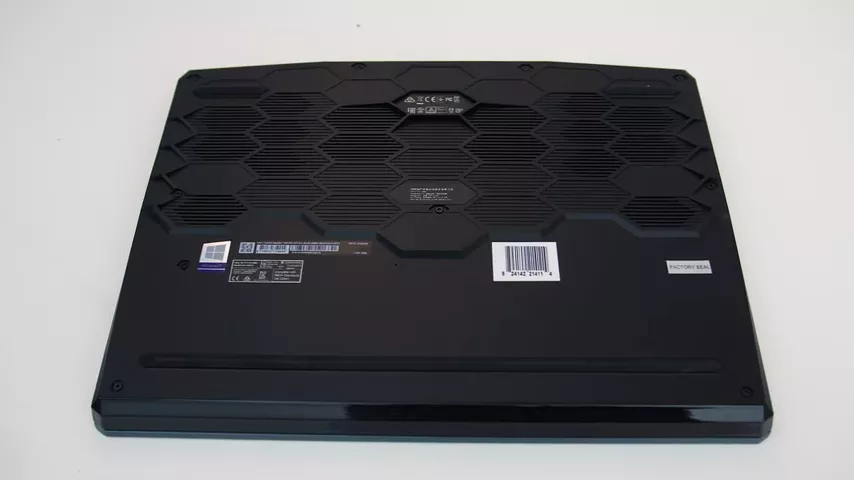 You need to take out 11 Phillips head screws to get inside, and I found it a bit challenging to get in.
You need to take out 11 Phillips head screws to get inside, and I found it a bit challenging to get in. 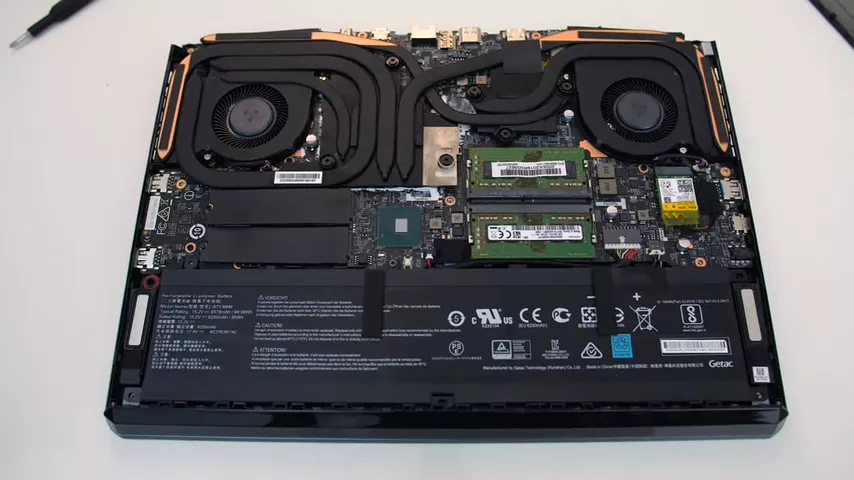 Inside we’ve got the large 99.9Wh battery down the bottom, two M.2 storage slots above it to the left, both of which do NVMe while one does SATA. There are two memory slots to the right of that, and a WiFi 6 card on the far right. It’s worth noting that MSI are using DDR4-3200 memory here, in most of their previous models I’ve tested they were still using slower DDR4-2666, so this is good to see, and we’ve also got the option to adjust memory timings through the advanced BIOS.
Inside we’ve got the large 99.9Wh battery down the bottom, two M.2 storage slots above it to the left, both of which do NVMe while one does SATA. There are two memory slots to the right of that, and a WiFi 6 card on the far right. It’s worth noting that MSI are using DDR4-3200 memory here, in most of their previous models I’ve tested they were still using slower DDR4-2666, so this is good to see, and we’ve also got the option to adjust memory timings through the advanced BIOS.
The two 2w speakers are found down the front on the left and right sides. There are no vents on the bottom panel for them, the sound comes out through the small holes on the sides. This may be why the speakers didn’t sound great, they were tinny sounding with no bass. They were loud enough at maximum volume, and the latencymon results were looking alright.
The GE66 has a 4-Cell 99.9Wh battery, basically the largest you can easily take on a plane. I’ve tested with the screen brightness at 50%, background apps disabled and RGB lighting off, and it lasted for over 7 hours in the YouTube playback test, one of the best results for a laptop of this hardware spec.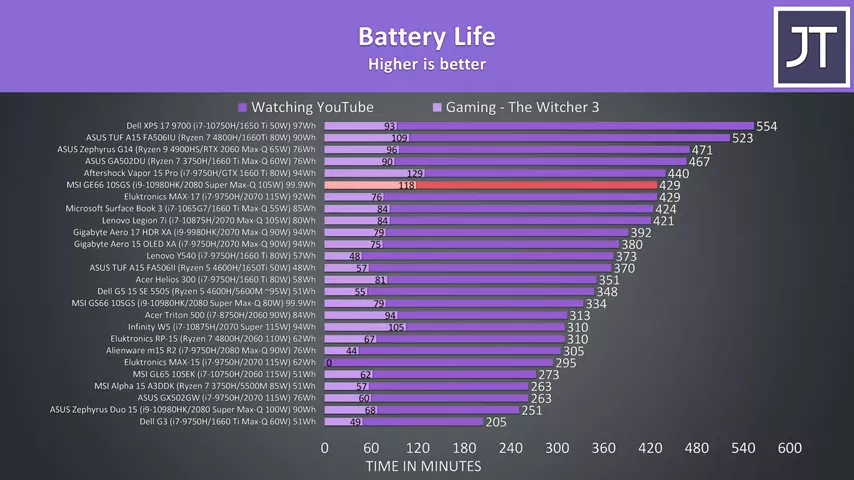 It almost lasted for two hours while gaming too without dipping below the 30 FPS Nvidia battery boost cap, another good result.
It almost lasted for two hours while gaming too without dipping below the 30 FPS Nvidia battery boost cap, another good result. 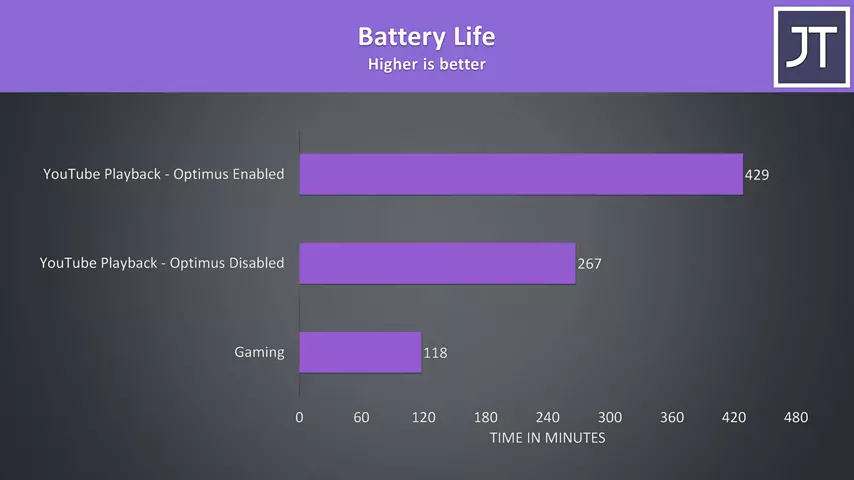 I’ve also tested with and without Optimus enabled, and as expected the battery lasts for a shorter period when running purely off the Nvidia discrete graphics. MSI also gives you the option of defining the level to charge to which may help prolong battery life based on your usage.
I’ve also tested with and without Optimus enabled, and as expected the battery lasts for a shorter period when running purely off the Nvidia discrete graphics. MSI also gives you the option of defining the level to charge to which may help prolong battery life based on your usage.
Let’s check out thermals next, I’ve got a detailed review covering this in depth if you want more information.
Inside we’ve got a couple of fans, and the heatpipes aren’t quite shared. 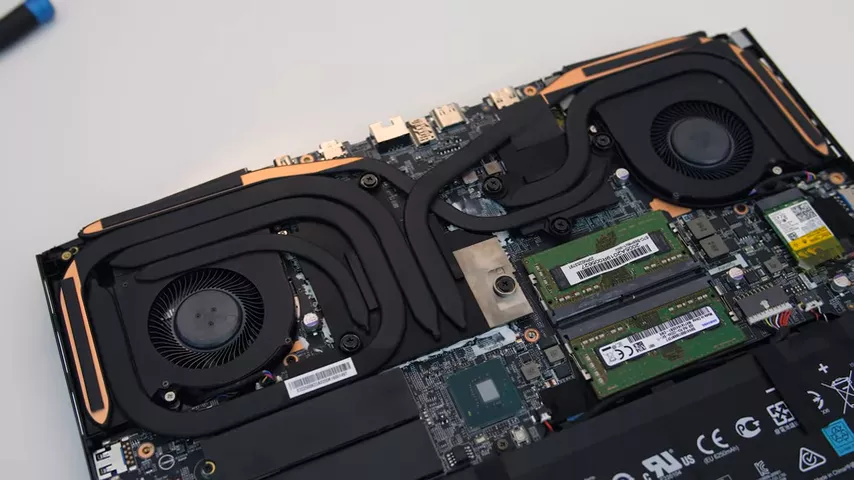 There are two pipes from either side that go across to the other component, but these aren’t touching both CPU and GPU dies. The MSI Dragon Center software lets you select between different performance modes, which from lowest to highest are silent, balanced and extreme. You’ve got the option of overclocking the GPU in extreme performance mode, however no overclock was applied by default. You can also toggle coolerboost here, which sets the fan to max speed, however there is some manual customization that can be done to CPU or GPU fan.
There are two pipes from either side that go across to the other component, but these aren’t touching both CPU and GPU dies. The MSI Dragon Center software lets you select between different performance modes, which from lowest to highest are silent, balanced and extreme. You’ve got the option of overclocking the GPU in extreme performance mode, however no overclock was applied by default. You can also toggle coolerboost here, which sets the fan to max speed, however there is some manual customization that can be done to CPU or GPU fan.
Like some other MSI laptops, I did have a strange bug here where most of the time I had the options available to change the modes, but sometimes they would just vanish until I rebooted the system, hopefully that can get fixed in an update. There’s also no undervolting done out of the box, and by default it’s disabled, however if you boot into the BIOS and then press Right Shift + Right Control + Left Alt + F2 you’ll be able to enable undervolting, as well as a ton of other options, so be careful and only change what you understand.
Although the RTX 2080 is Max-Q, it’s using Nvidia’s new Dynamic Boost, which means the power limit can boost higher depending on if there is power available. I saw a 105 watt average in a GPU only stress test, but it will be less with the CPU active, closer to its regular 90 watt limit which is what happens if dynamic boost were to be disabled.
Thermals were tested with a 21 degree Celsius ambient room temperature.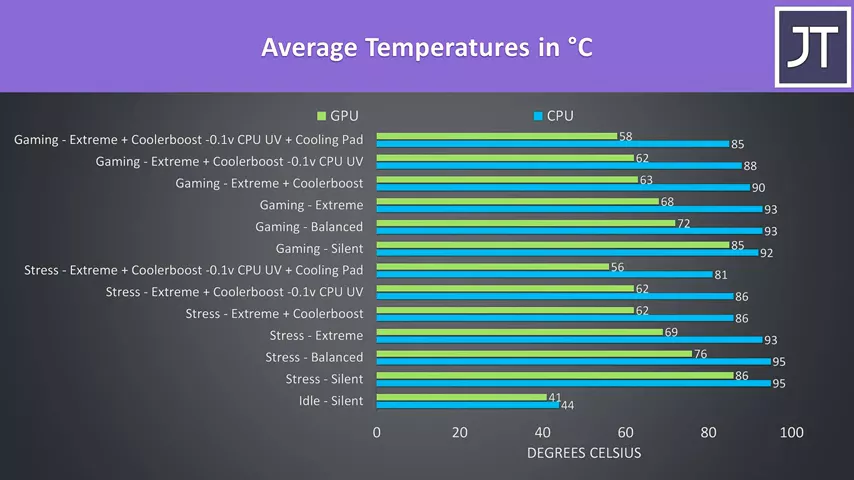 Idle results down the bottom were ok. Worst case stress tests were done with the Aida64 CPU stress test with CPU only checked and the Heaven benchmark at max settings at the same time, while gaming was tested with Watch Dogs 2. The CPU was hitting thermal throttling at 95 degrees, but this was only happening while under worst case stress test in the silent and balanced modes. It was a little cooler in extreme mode, and if we set the fan to max with coolerboost it’s a fair bit lower, then even better if we use a cooling pad.
Idle results down the bottom were ok. Worst case stress tests were done with the Aida64 CPU stress test with CPU only checked and the Heaven benchmark at max settings at the same time, while gaming was tested with Watch Dogs 2. The CPU was hitting thermal throttling at 95 degrees, but this was only happening while under worst case stress test in the silent and balanced modes. It was a little cooler in extreme mode, and if we set the fan to max with coolerboost it’s a fair bit lower, then even better if we use a cooling pad.
These are the clock speeds for the same tests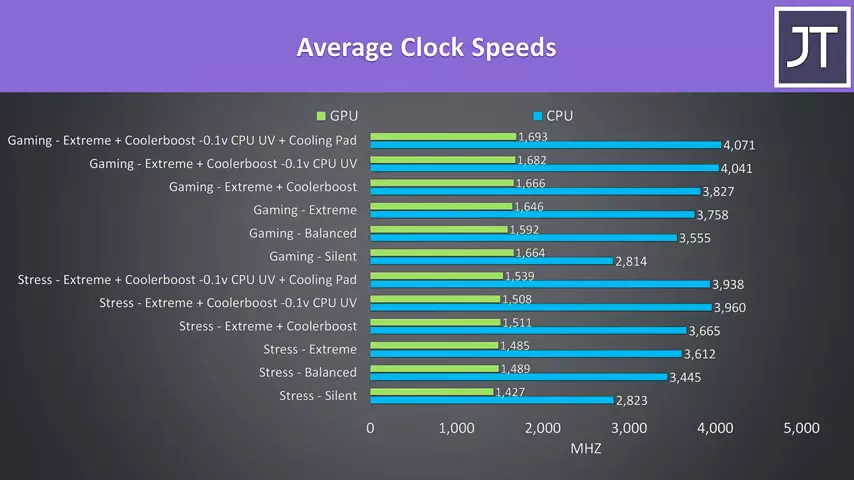 we’re seeing around 3.6GHz for the clock speed on average over all 8 cores, I’d expect higher speeds from the 6 core option as there are fewer cores to power, but undervolting allowed us to push this up to 4GHz.
we’re seeing around 3.6GHz for the clock speed on average over all 8 cores, I’d expect higher speeds from the 6 core option as there are fewer cores to power, but undervolting allowed us to push this up to 4GHz. 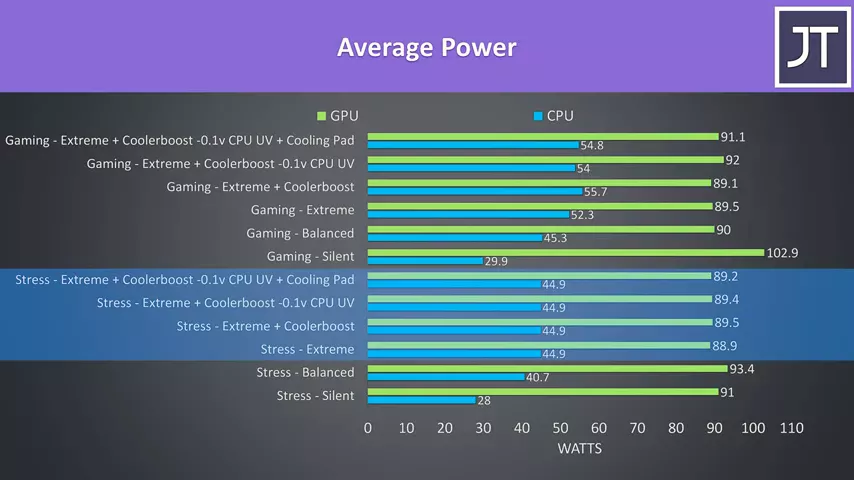 This seems to be due to the 45 watt power limit that was observed with the stress test running. Both the BIOS and software reported a 200 watt PL1, so it seems that something is overwriting this to prevent things getting too hot. When the CPU is less loaded the GPU power limit rises as a result of Max-Q dynamic boost.
This seems to be due to the 45 watt power limit that was observed with the stress test running. Both the BIOS and software reported a 200 watt PL1, so it seems that something is overwriting this to prevent things getting too hot. When the CPU is less loaded the GPU power limit rises as a result of Max-Q dynamic boost.
Here’s how a game actually performs with these different settings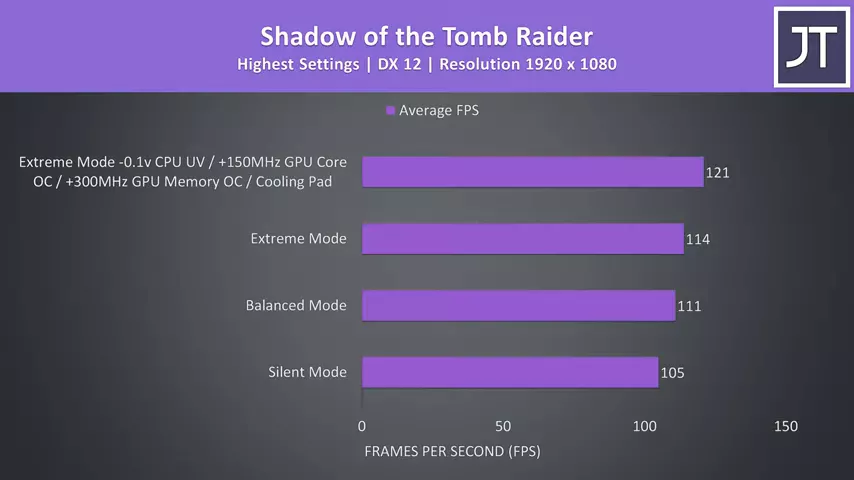 so we’re still seeing above 100 FPS in silent mode which is a great result and due to the higher GPU power levels seen in this mode. We could get a 6% boost by overclocking, undervolting and using a cooling pad.
so we’re still seeing above 100 FPS in silent mode which is a great result and due to the higher GPU power levels seen in this mode. We could get a 6% boost by overclocking, undervolting and using a cooling pad.
Here’s how the different modes perform in Cinebench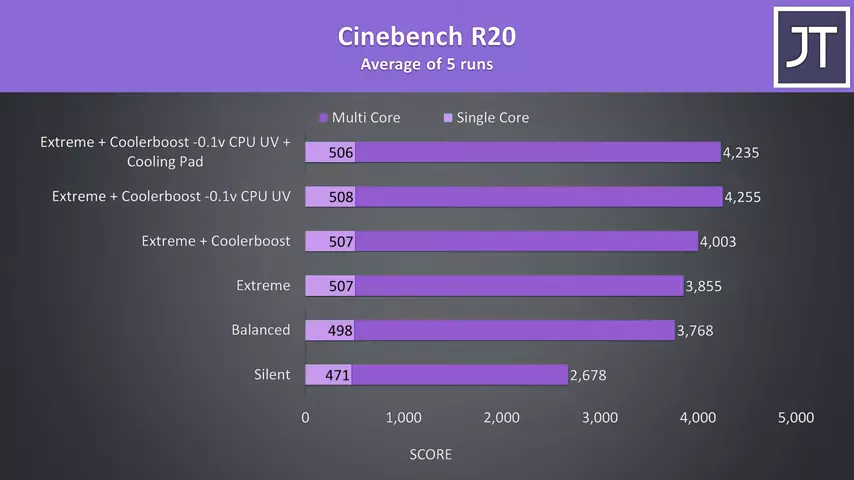 a CPU only workload with the GPU now inactive.
a CPU only workload with the GPU now inactive.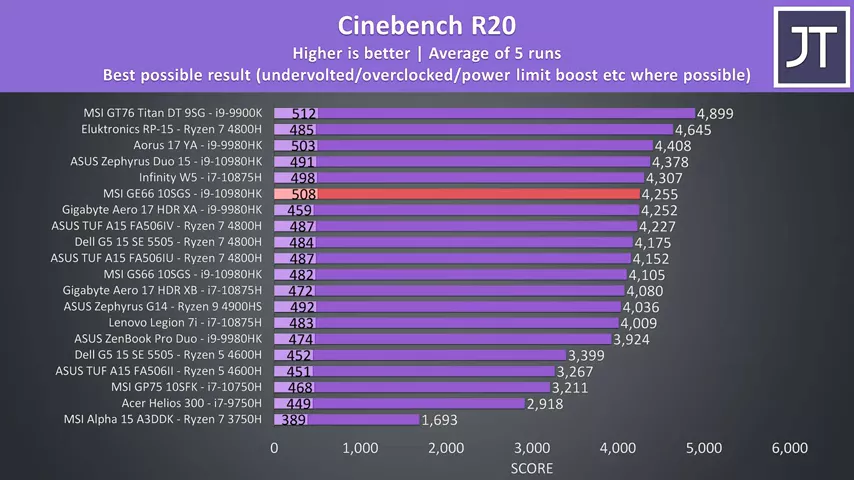 When we look at how it compares against other 8 core laptops, it’s one of the better results, especially the single core performance, though multicore was beaten by the much cheaper Eluktronics RP-15 with Ryzen 7 4800H.
When we look at how it compares against other 8 core laptops, it’s one of the better results, especially the single core performance, though multicore was beaten by the much cheaper Eluktronics RP-15 with Ryzen 7 4800H.
As for the external temperatures where you’ll actually be putting your hands, at idle in silent mode it was in the low 30s, pretty standard. 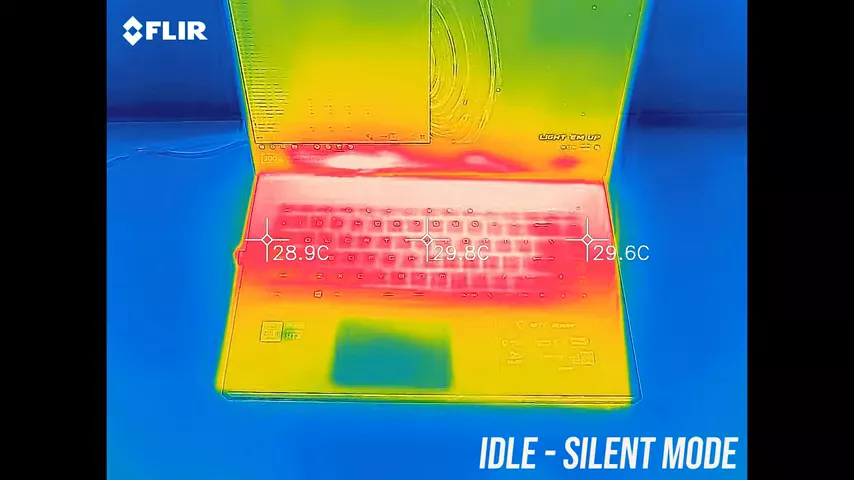 With the stress tests going the wrist rests are cool, it’s quite warm in the center and hot to the touch up the back, though you don’t need to touch there.
With the stress tests going the wrist rests are cool, it’s quite warm in the center and hot to the touch up the back, though you don’t need to touch there.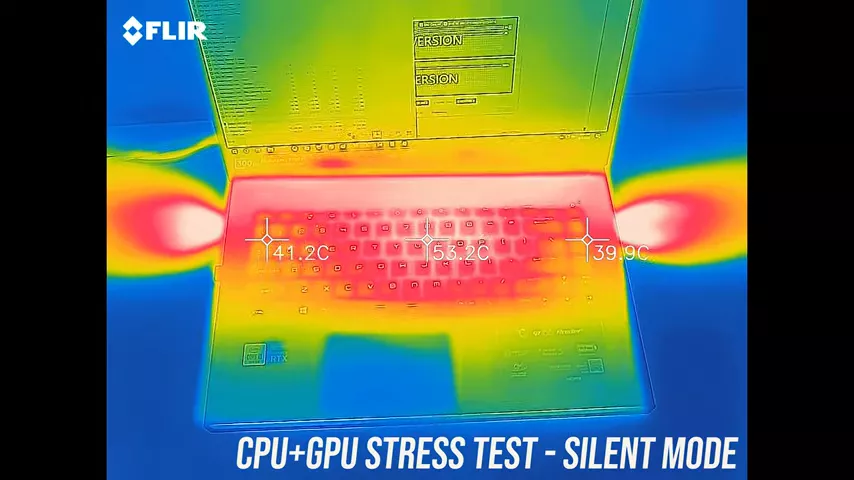 It’s a little cooler in balanced mode as the fans increase here
It’s a little cooler in balanced mode as the fans increase here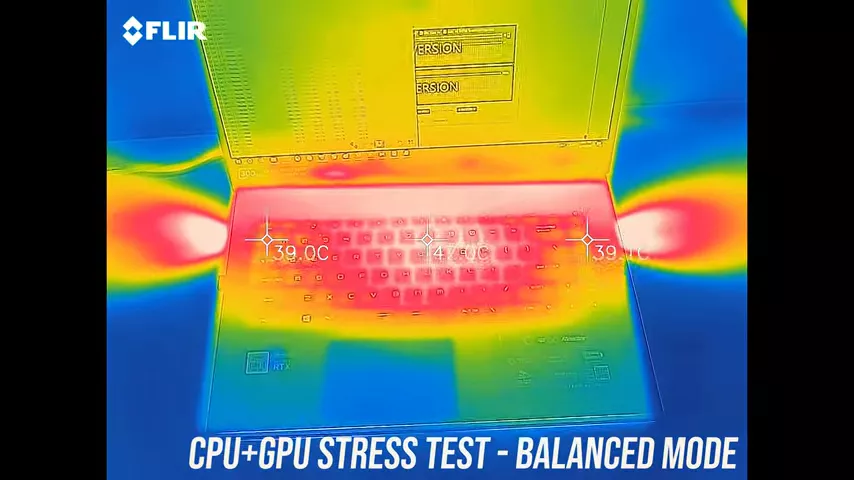 perhaps a little cooler still with extreme mode, the middle was a bit warm but not bad.
perhaps a little cooler still with extreme mode, the middle was a bit warm but not bad. 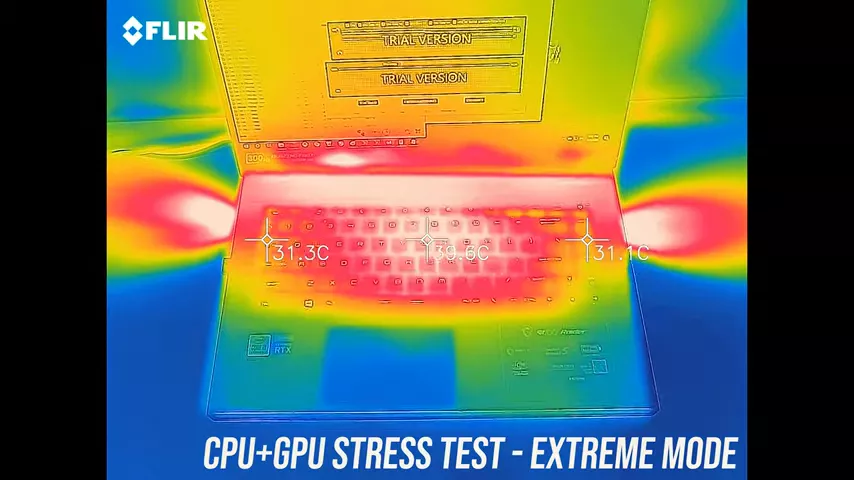 With coolerboost enabled it gets a fair bit cooler to the touch and the wrist rests are still cool.
With coolerboost enabled it gets a fair bit cooler to the touch and the wrist rests are still cool.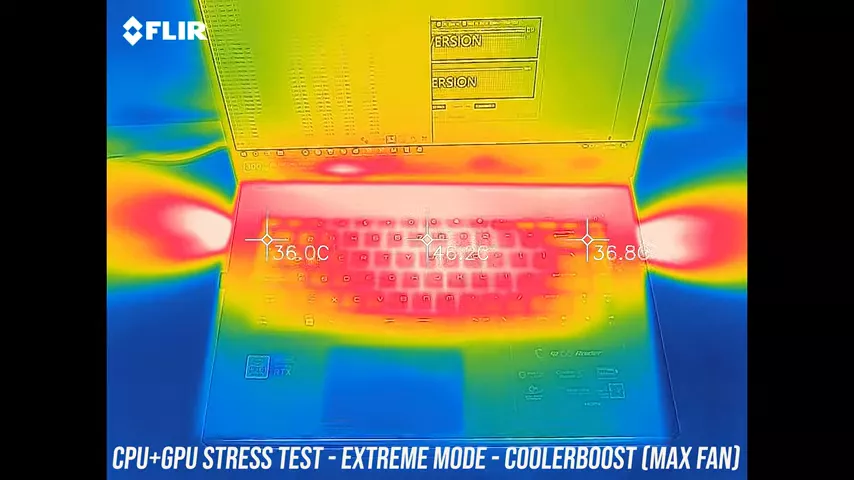 At idle the fans were just audible, but from time to time they would boost up a bit louder, and this was to a similar level as just watching a YouTube video and browsing Chrome. With the stress tests going in silent mode it’s still on the quieter side, and if you recall gaming performance was still quite good there, so gaming with a quieter machine is definitely possible at the expense of higher temperatures. Balanced mode was louder, but still lower compared to most gaming laptops.
At idle the fans were just audible, but from time to time they would boost up a bit louder, and this was to a similar level as just watching a YouTube video and browsing Chrome. With the stress tests going in silent mode it’s still on the quieter side, and if you recall gaming performance was still quite good there, so gaming with a quieter machine is definitely possible at the expense of higher temperatures. Balanced mode was louder, but still lower compared to most gaming laptops.
Cooler boost is quite loud, you’ll definitely want headphones or something, but I think this is a good thing. As there is some fan control and the different modes it gives you the choice of running it how you like, cooler and louder, or warmer and quieter, and I think having the option is better than being stuck one way or the other.
Now let’s take a look at how the GE66 with these specs compares against other laptops in games, use these results as a rough guide only, as they were tested at different times with different drivers.
In Battlefield 5 I’ve got the GE66 highlighted in red.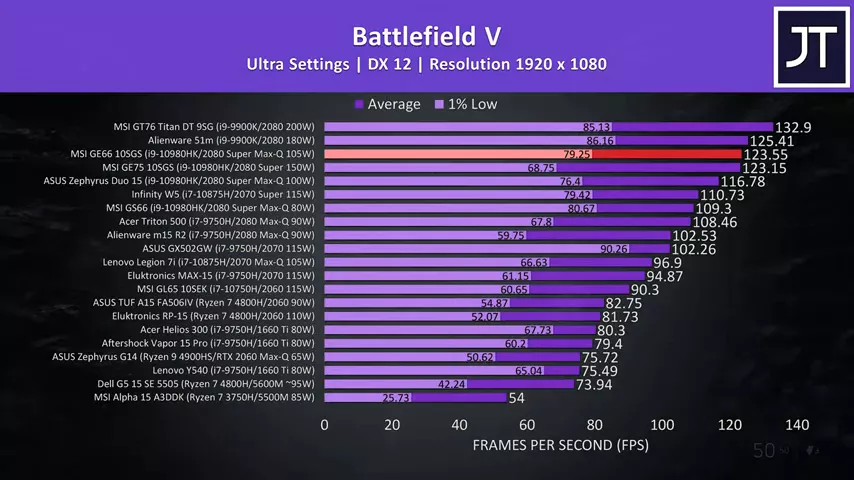 It’s giving a great result when compared to others, beating the thicker GE75 with higher wattage non max-q graphics below it, which would be a result of the faster DDR4-3200 memory and option of disabling optimus. We’re only seeing better results with even larger machines with desktop tier processors inside.
It’s giving a great result when compared to others, beating the thicker GE75 with higher wattage non max-q graphics below it, which would be a result of the faster DDR4-3200 memory and option of disabling optimus. We’re only seeing better results with even larger machines with desktop tier processors inside.
These are the results from Far Cry 5 with ultra settings in the built in benchmark. 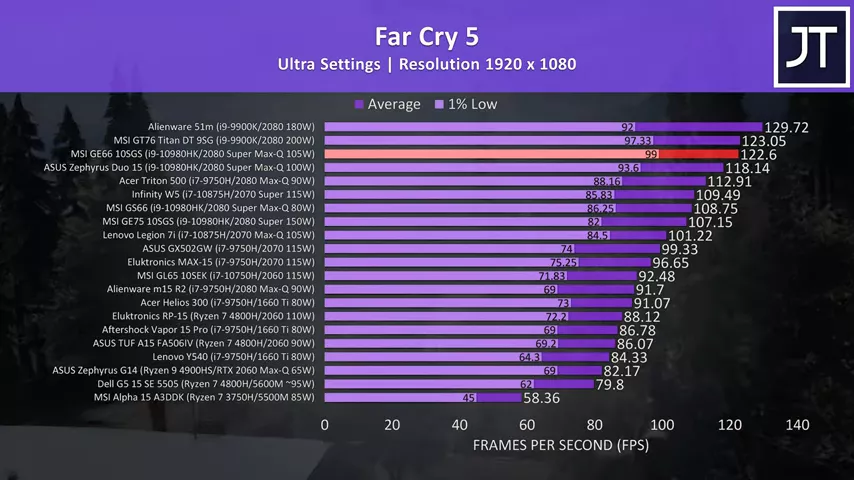 Again the GE66 is doing extremely well here, actually offering the best 1% lows out of all laptops shown here, and again not far behind the much chunkier and more powerful options.
Again the GE66 is doing extremely well here, actually offering the best 1% lows out of all laptops shown here, and again not far behind the much chunkier and more powerful options. 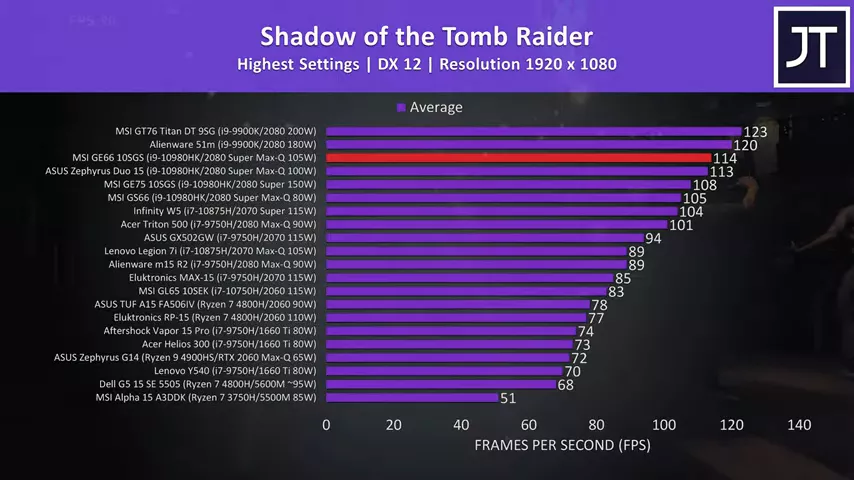 Shadow of the Tomb Raider was also tested with the games benchmark tool, and again the GE66 is in the same position in relation to the other machines tested, near the top and only behind the thicker, more expensive options. Again the fact that it’s ahead of the GE75 which is thicker and has a higher wattage GPU really goes to show the benefits of being able to disable optimus.
Shadow of the Tomb Raider was also tested with the games benchmark tool, and again the GE66 is in the same position in relation to the other machines tested, near the top and only behind the thicker, more expensive options. Again the fact that it’s ahead of the GE75 which is thicker and has a higher wattage GPU really goes to show the benefits of being able to disable optimus.
I’ve also tested the GE66 in 21 different games at all setting levels.
Now for the benchmarking tools. 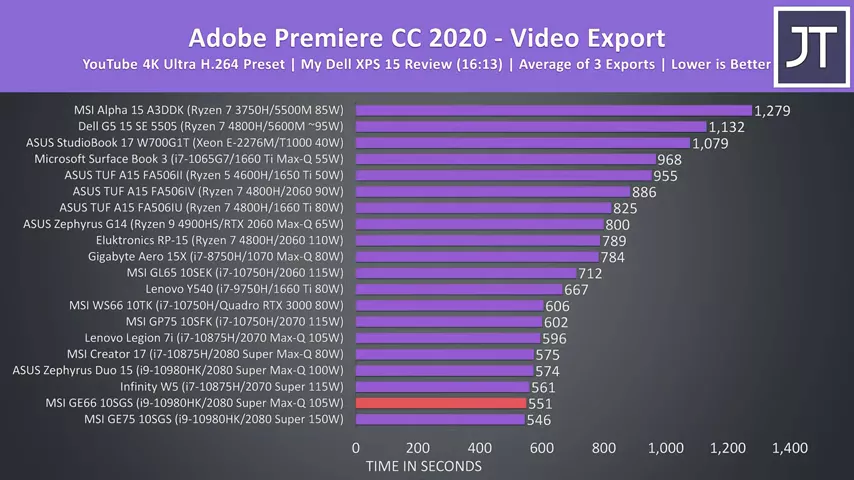 I’ve used Adobe Premiere to export one of my laptop review videos at 4K, and the GE66 is in second place out of all laptops that I’ve tested so far, a good result due to the good specs.
I’ve used Adobe Premiere to export one of my laptop review videos at 4K, and the GE66 is in second place out of all laptops that I’ve tested so far, a good result due to the good specs. 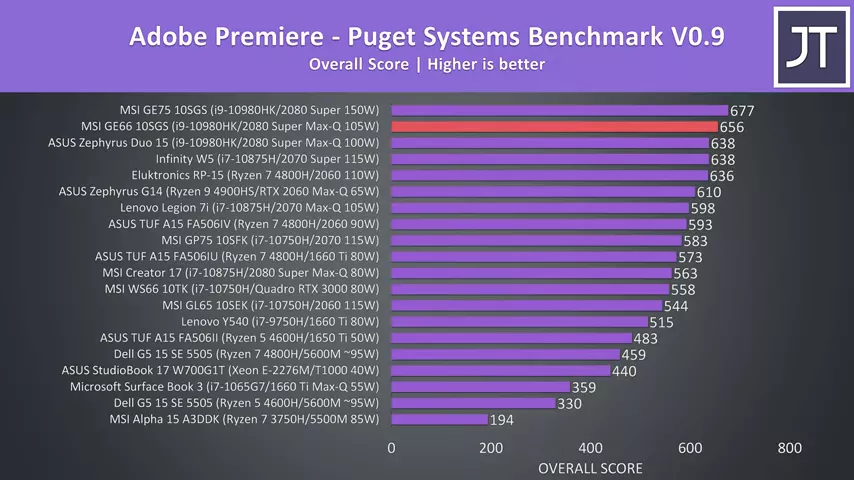 I’ve also tested Premiere but with the Puget systems benchmark which also accounts for things like live playback rather than just export times, and again the GE66 was second best.
I’ve also tested Premiere but with the Puget systems benchmark which also accounts for things like live playback rather than just export times, and again the GE66 was second best. 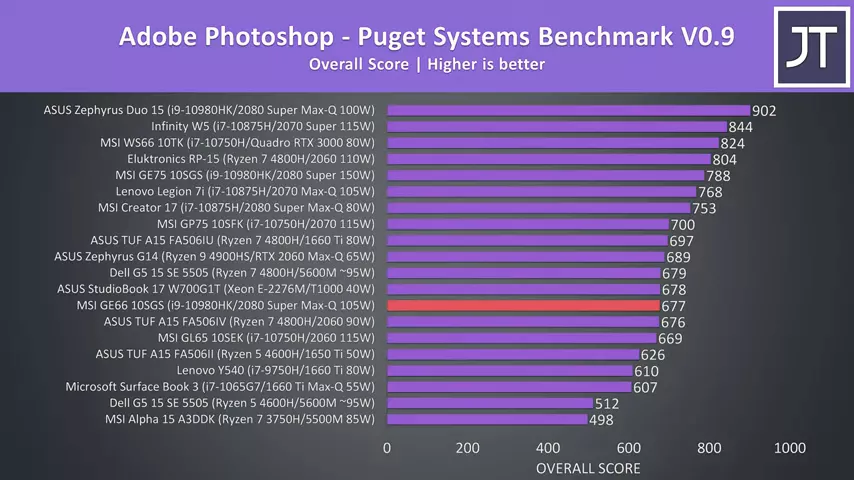 The results were lower when looking at Adobe Photoshop, I suspect because this is a CPU heavy test and the processor of the GE66 is capped to 45 watts in workloads where the GPU is active.
The results were lower when looking at Adobe Photoshop, I suspect because this is a CPU heavy test and the processor of the GE66 is capped to 45 watts in workloads where the GPU is active. 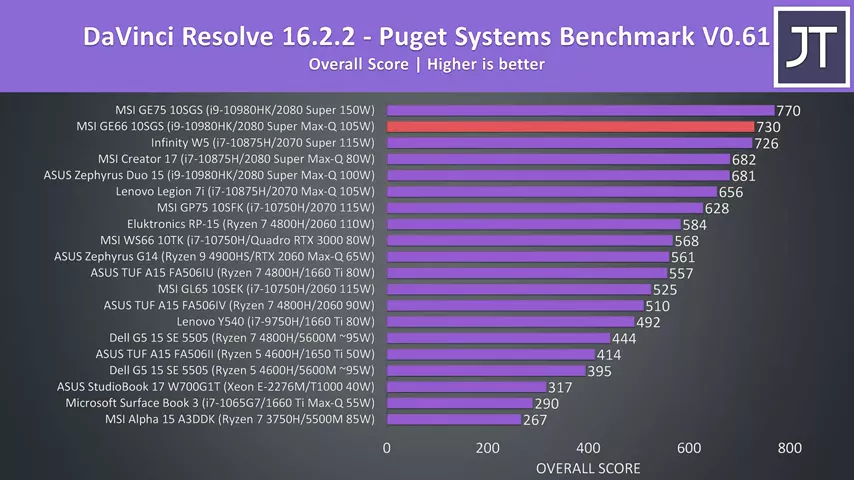 The GE66 was back in second place for DaVinci resolve though, as this is a GPU heavy test.
The GE66 was back in second place for DaVinci resolve though, as this is a GPU heavy test.  I’ve also tested SPECviewperf which tests out various professional 3D workloads.
I’ve also tested SPECviewperf which tests out various professional 3D workloads. 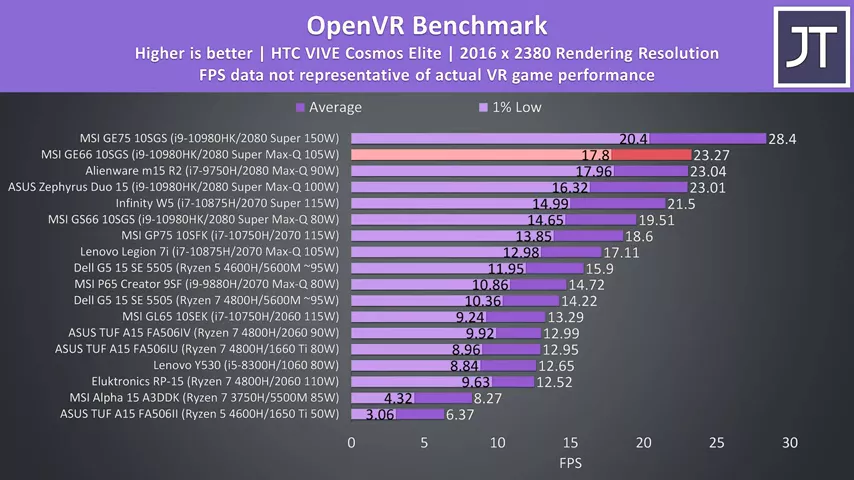 I’ve used the OpenVR benchmark to test the HTC Vive Cosmos Elite, and the GE66 was in second place here as well, definitely no issues at all running VR games with this combination of hardware.
I’ve used the OpenVR benchmark to test the HTC Vive Cosmos Elite, and the GE66 was in second place here as well, definitely no issues at all running VR games with this combination of hardware.  I’ve used Crystal Disk Mark to test the storage. The 1TB NVMe M.2 SSD was performing very well, and the SD card slot was good for the reads, but much lower on the writes comparatively, which is less of an issue in my opinion as most people will be using it to dump footage.
I’ve used Crystal Disk Mark to test the storage. The 1TB NVMe M.2 SSD was performing very well, and the SD card slot was good for the reads, but much lower on the writes comparatively, which is less of an issue in my opinion as most people will be using it to dump footage.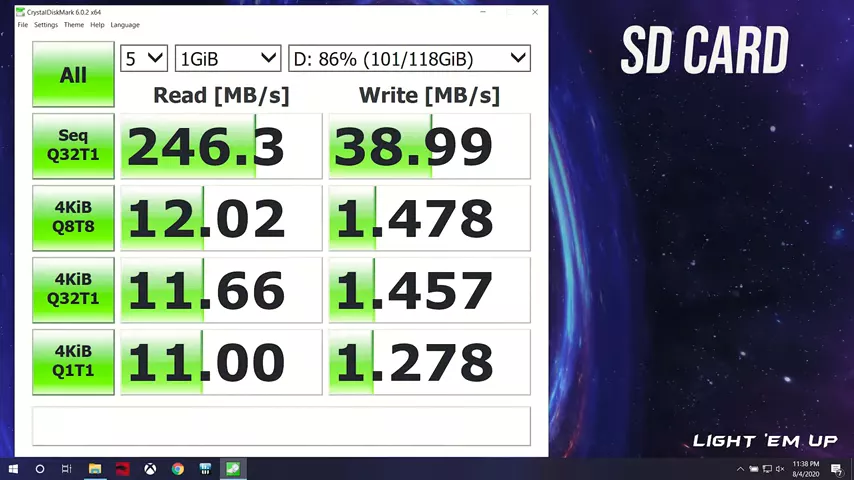 The SD card clicks in most of the way into the machine.
The SD card clicks in most of the way into the machine.
In the US the GE66 with the top end specs I’ve tested here is $3000 USD, but the lower specced model with 6 core i7 and 2070 graphics is $1800 USD. Here in Australia we’re looking at $3300 AUD for the 2060 model, while the 10SGS spec I’ve tested is a fair bit higher. The GE66 will also be available in the limited edition dragon shield version.
Alright with everything tested let’s conclude by summarising the good and bad aspects of MSI’s GE66 gaming laptop to help you decide if it’s worthwhile. Overall the gaming performance from the GE66 was quite good, and this is due to the combination of Max-Q dynamic boost, option of disabling Optimus, and the addition of DDR4-3200 memory would be helping too. This combination gives us great results, which I’d also expect to see from the lower specced models too.
Thermals aren’t too bad in extreme mode, especially if you’re willing to turn up the fan speed they’re actually quite good, but this seems to be due to power limits in place on the processor. This is why it doesn’t get super hot, but it’s hard to complain about not having a higher power limit when by most metrics measured, whether that be gaming, Cinebench or content creator suites, we’re seeing the GE66 consistently doing very nicely.
The option of being able to enable undervolting and make further tweaks to power limits, thermal limits and memory timings is also awesome. While I appreciate the option of disabling Optimus to get a speed boost, something that the more powerful GE75 is missing, there’s no G-Sync here which would have been icing on the cake, but at least fast sync is possible. The 300Hz screen can be utilized in esports titles, but I found it a bit strange that MSI haven’t given the option of enabling overdrive to hit the 3ms response time required to ensure all transitions complete within the refresh window.
Aside from that though, the screen has decent brightness, good contrast and colours for a gaming panel. Build quality was decent, and the battery life with the large 99.9Wh battery gave me some of the best results I’ve ever seen from a gaming laptop with this high end tier of specs inside. The speakers weren’t great, but interestingly MSI have a 1080p camera, most others only go with 720p. At the end of the day, the GE66 is definitely one of the better laptops I’ve tested from MSI, there’s just not that much to complain about, and if RGB bling is your thing then it’s got you covered.
Let me know what you thought about MSI’s GE66 Raider gaming laptop down in the comments.
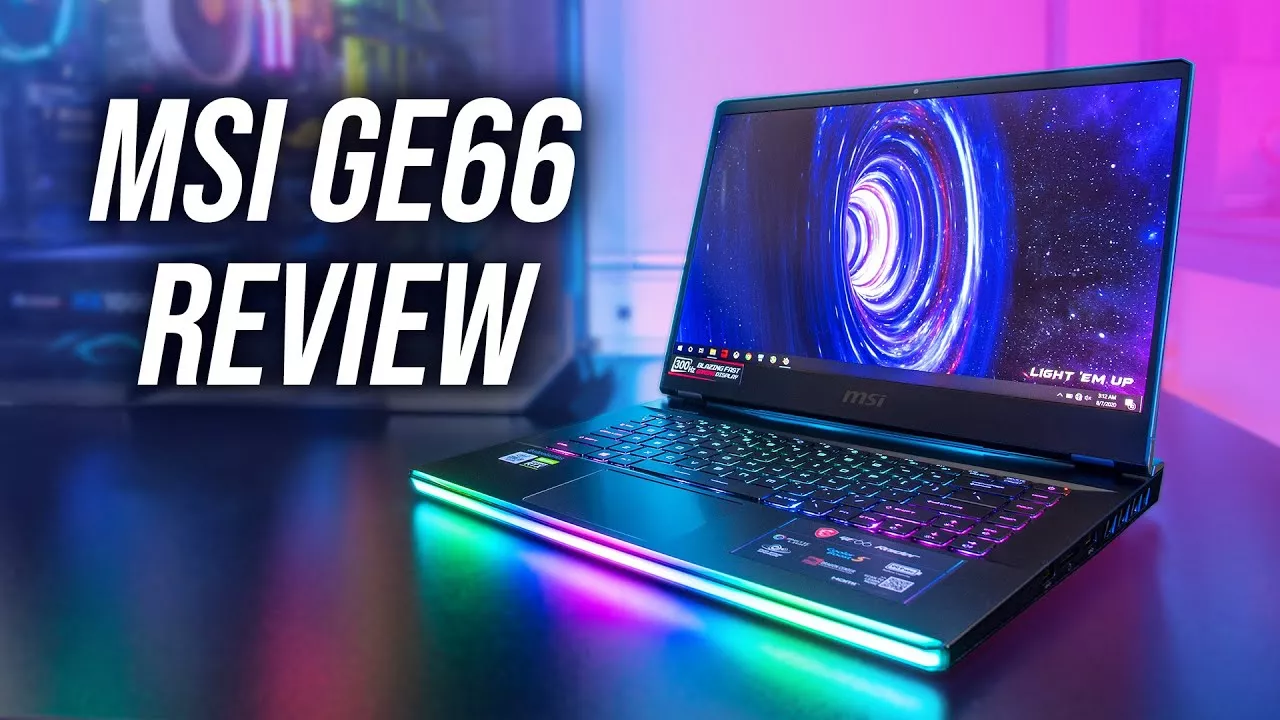

No comments yet